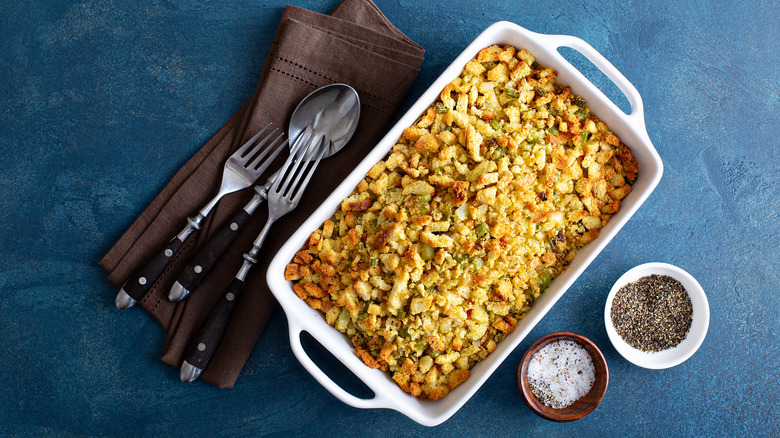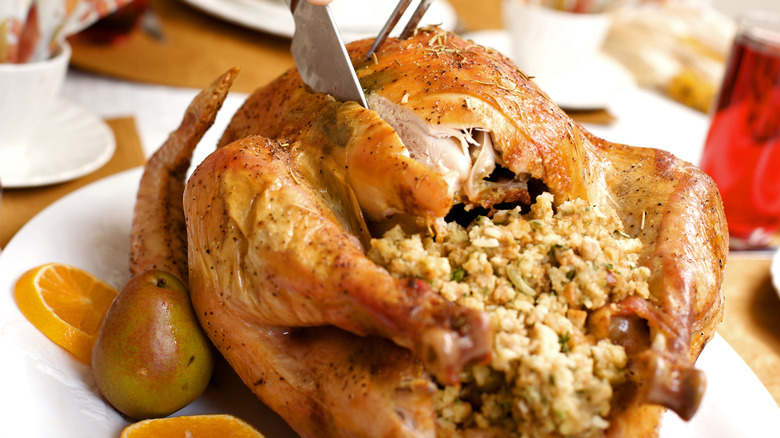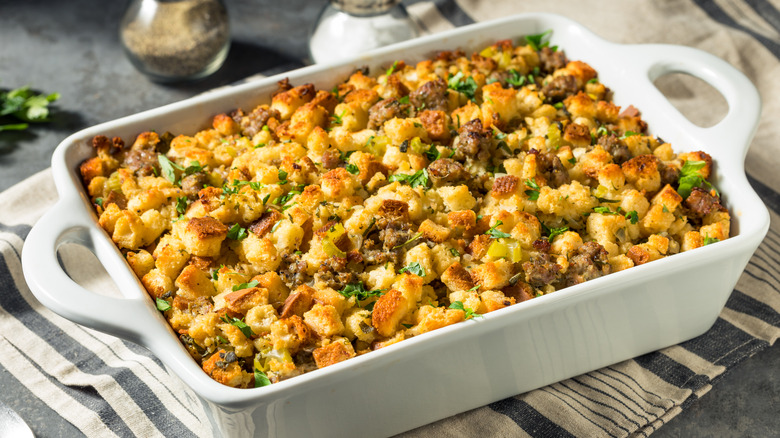Dressing Vs Stuffing: The Differences You Need To Know
If you're roasting up a turkey (or possibly chicken, too), there's a good chance you're going to also grab some bread, herbs, and more to whip up some stuffing — or potentially some dressing. And while these two sides are fairly similar, especially when it comes to ingredients, there's a key difference when it comes to the cooking method.
For both dishes, you'll usually assemble some combination of herbs, vegetables, and a starch (often, but not always, bread). The most important difference is what you do with this mixture: For stuffing, you'll stuff it into the cavity of the turkey or chicken and it'll cook there, soaking in juices. Meanwhile, dressing involves cooking those ingredients in their own baking dish, separate from the bird.
But pay attention, as there can be some linguistic ambiguity here. Some people may occasionally use the term "dressing" interchangeably with "stuffing." In this case, both terms refer to bready filling that's stuffed inside the bird. This came about in the 1800s when, according to common theory around the word change, overly polite society probably found the word "stuffing" to be a little too graphic for their liking. This more confusing usage seems to have faded, with a general (but not unanimous) agreement that "dressing" refers to this filling being cooked outside of the bird. However, you will likely still encounter this language switch in the South.
How the stuffing and dressing are made
First, know that there's no one "right" way to make stuffing or dressing. There are a phenomenal number of recipes out there, and opinions vary. For example, while some culinary resources suggest that a classic stuffing or dressing is made with bread, stuffing is realistically a lot more flexible, and you can use other starches like barley or rice. In the South, you'll often see cornbread in place of regular wheat-based breads, too.
But for the sake of comparison, let's focus on making dressing or stuffing with similar, bread-based recipes. Such recipes will usually call for bread, vegetables like onion and celery, herbs like sage and rosemary, broth, and eggs. In both cases you'll usually dry out the bread first (or use older bread that's already dried out), either in the open air or in an oven on a low temperature. The vegetables need to be cooked, and you'll mix those together with the bread, herbs and flavorings (like garlic). Lastly, stock will be added (and sometimes eggs for binding) to moisten it a bit. Bear in mind that dressing can dry out, so it may need more liquid.
Next, the recipes diverge: For stuffing, you'll gather it up and stuff it into the turkey cavity, and you'll bake it for as long as the turkey needs to be done (and until it's at least 165 degrees Fahrenheit). Dressing may only need an hour in the oven, so you can prepare it while the turkey is already roasting.
Why choose one over the other?
It's not hard to find cooks and culinary experts asserting that stuffing is a better option than dressing: The argument goes that because stuffing soaks in the turkey's juices, it'll be more flavorful. And while it's a fair point, it doesn't mean there aren't valid reasons for making dressing.
For example, if your Thanksgiving dinner has vegan or vegetarian guests, you may want to opt for dressing so that they can partake too — obviously, something cooked inside of a turkey isn't vegetarian. You may need to make adjustments, as eggs, butter, and meat-based broths can all appear in dressing, but it's otherwise not a difficult vegetarian or vegan dish.
Some people may prefer the texture of dressing: Since it's baked in the open, it can crisp up and get crunchy. Stuffing, on the other hand, will always be soft and moist (although you still want to be careful to not make it too wet) — this can be too soggy for some tastes.
Of course, there may be times when stuffing just isn't feasible — for example, if you're just roasting part of a turkey, you won't have a cavity in which to bake the stuffing. In such cases, dressing baked outside the turkey is your only option.


